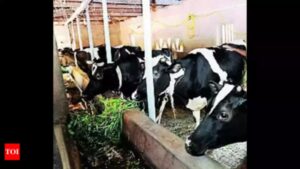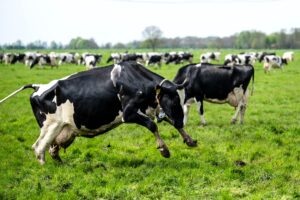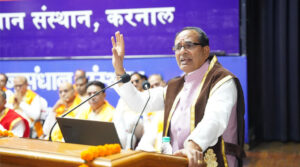
Rising temperatures have resulted in a significant decline in milk production among dairy cattle in the district, with farmers experiencing a reduction of up to 35% due to heat stress. Experts in animal husbandry are now offering insights and strategies to mitigate the impact of heat stress on milch animals and sustain dairy productivity.
Dairy farmers have reported the adverse effects of scorching temperatures, which not only diminish profits but also compromise the well-being of livestock. Heat-induced diseases, including mastitis, foot-and-mouth disease (FMD), and hemorrhagic septicemia (HS), have become prevalent.
The Detrimental Impact of Heat Stress on Dairy Cattle:
A report published by the National Library of Medicine sheds light on the detrimental consequences of heat stress on dairy cattle. The study reveals a range of negative effects, such as decreased milk production, reduced feed intake, impaired reproductive performance, and heightened susceptibility to diseases.
Heat stress causes physiological changes in cattle, including increased heart and respiration rates, elevated blood flow to the skin, and excessive sweating. These factors contribute to electrolyte imbalance, dehydration, and inflammation, resulting in significant economic losses for the dairy industry.
Health Complications and Increased Veterinary Cases:
Heat stress also leads to various health complications in cows, requiring extended care. Difficult births, heat exhaustion, fatty liver in fresh cows, mastitis, adverse reactions to vaccinations resulting in abortions and death, and increased lameness are among the challenges faced. Rising ambient temperatures also cause escalated respiratory rates, progressing from panting to open-mouth breathing.
The Impact on Veterinary Services:
Veterinary services are witnessing a sharp rise in daily outpatient department (OPD) cases, with the number doubling from the usual 15-20 cases to 40 cases per day. Farmers are reporting reduced milk quantity due to heat stress, while other health ailments are surfacing as animals’ immunity is compromised in extreme temperatures.
Mitigating Heat Stress:
Experts recommend implementing various measures to alleviate heat stress in livestock. Installing fans, sprinklers, and providing ample shade, ventilation, and cool drinking water are crucial steps in maintaining animal welfare. Adjusting feeding times to coincide with cooler periods of the day can help sustain feed intake levels.
Dr. Parminder Singh, an animal nutrition expert, emphasizes the importance of a well-balanced diet in combating heat stress. Carefully planned diets can minimize the adverse effects on milk production while ensuring that animals receive sufficient nutrition to boost immunity and withstand extreme weather conditions.
Dr. Singh suggests incorporating special additives into animal feed during summers to enhance digestibility and palatability. Additionally, understanding the animals’ body clock and feeding them during cooler hours, such as early morning or late at night, is beneficial. Maintaining a 12-hour interval between consecutive milking sessions is also crucial for optimal results.
Title: Heat Stress Takes a Toll on Dairy Cattle, Impeding Milk Production
Introduction:
Rising temperatures have resulted in a significant decline in milk production among dairy cattle in the district, with farmers experiencing a reduction of up to 35% due to heat stress. Experts in animal husbandry are now offering insights and strategies to mitigate the impact of heat stress on milch animals and sustain dairy productivity.
Dairy farmers have reported the adverse effects of scorching temperatures, which not only diminish profits but also compromise the well-being of livestock. Heat-induced diseases, including mastitis, foot-and-mouth disease (FMD), and hemorrhagic septicemia (HS), have become prevalent.
The Detrimental Impact of Heat Stress on Dairy Cattle:
A report published by the National Library of Medicine sheds light on the detrimental consequences of heat stress on dairy cattle. The study reveals a range of negative effects, such as decreased milk production, reduced feed intake, impaired reproductive performance, and heightened susceptibility to diseases.
Heat stress causes physiological changes in cattle, including increased heart and respiration rates, elevated blood flow to the skin, and excessive sweating. These factors contribute to electrolyte imbalance, dehydration, and inflammation, resulting in significant economic losses for the dairy industry.
Health Complications and Increased Veterinary Cases:
Heat stress also leads to various health complications in cows, requiring extended care. Difficult births, heat exhaustion, fatty liver in fresh cows, mastitis, adverse reactions to vaccinations resulting in abortions and death, and increased lameness are among the challenges faced. Rising ambient temperatures also cause escalated respiratory rates, progressing from panting to open-mouth breathing.
The Impact on Veterinary Services:
Veterinary services are witnessing a sharp rise in daily outpatient department (OPD) cases, with the number doubling from the usual 15-20 cases to 40 cases per day. Farmers are reporting reduced milk quantity due to heat stress, while other health ailments are surfacing as animals’ immunity is compromised in extreme temperatures.
Mitigating Heat Stress:
Experts recommend implementing various measures to alleviate heat stress in livestock. Installing fans, sprinklers, and providing ample shade, ventilation, and cool drinking water are crucial steps in maintaining animal welfare. Adjusting feeding times to coincide with cooler periods of the day can help sustain feed intake levels.
Dr. Parminder Singh, an animal nutrition expert, emphasizes the importance of a well-balanced diet in combating heat stress. Carefully planned diets can minimize the adverse effects on milk production while ensuring that animals receive sufficient nutrition to boost immunity and withstand extreme weather conditions.
Dr. Singh suggests incorporating special additives into animal feed during summers to enhance digestibility and palatability. Additionally, understanding the animals’ body clock and feeding them during cooler hours, such as early morning or late at night, is beneficial. Maintaining a 12-hour interval between consecutive milking sessions is also crucial for optimal results.






